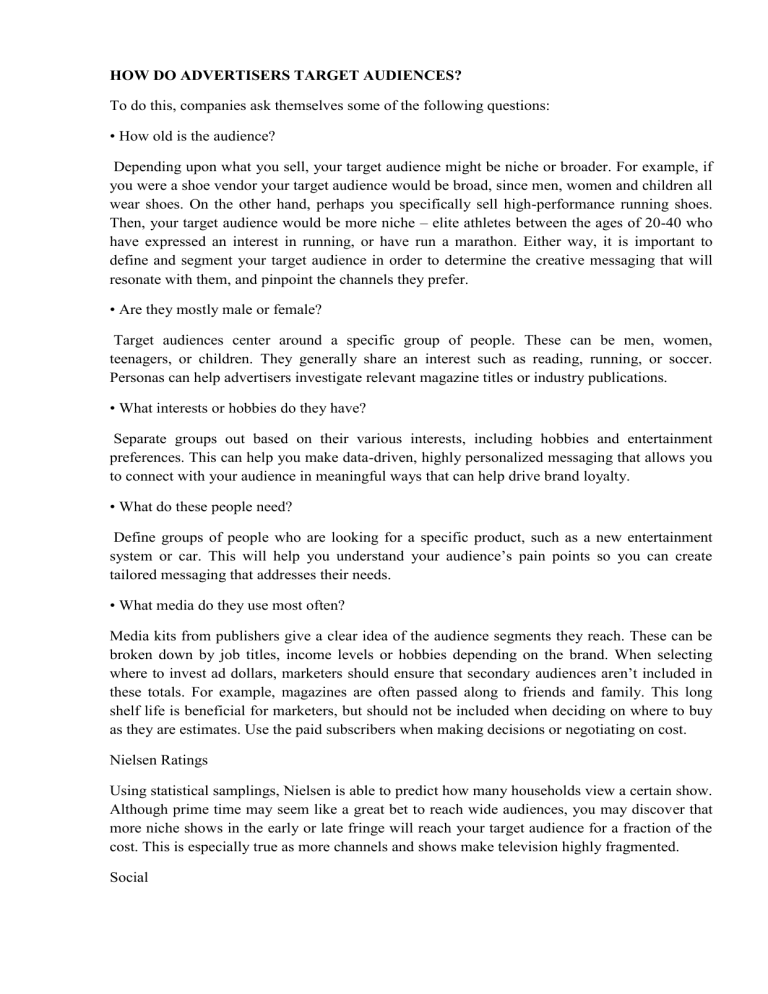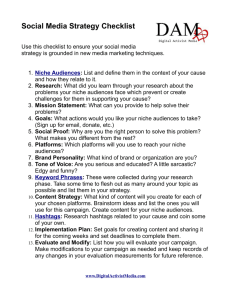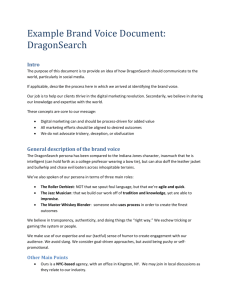
HOW DO ADVERTISERS TARGET AUDIENCES? To do this, companies ask themselves some of the following questions: • How old is the audience? Depending upon what you sell, your target audience might be niche or broader. For example, if you were a shoe vendor your target audience would be broad, since men, women and children all wear shoes. On the other hand, perhaps you specifically sell high-performance running shoes. Then, your target audience would be more niche – elite athletes between the ages of 20-40 who have expressed an interest in running, or have run a marathon. Either way, it is important to define and segment your target audience in order to determine the creative messaging that will resonate with them, and pinpoint the channels they prefer. • Are they mostly male or female? Target audiences center around a specific group of people. These can be men, women, teenagers, or children. They generally share an interest such as reading, running, or soccer. Personas can help advertisers investigate relevant magazine titles or industry publications. • What interests or hobbies do they have? Separate groups out based on their various interests, including hobbies and entertainment preferences. This can help you make data-driven, highly personalized messaging that allows you to connect with your audience in meaningful ways that can help drive brand loyalty. • What do these people need? Define groups of people who are looking for a specific product, such as a new entertainment system or car. This will help you understand your audience’s pain points so you can create tailored messaging that addresses their needs. • What media do they use most often? Media kits from publishers give a clear idea of the audience segments they reach. These can be broken down by job titles, income levels or hobbies depending on the brand. When selecting where to invest ad dollars, marketers should ensure that secondary audiences aren’t included in these totals. For example, magazines are often passed along to friends and family. This long shelf life is beneficial for marketers, but should not be included when deciding on where to buy as they are estimates. Use the paid subscribers when making decisions or negotiating on cost. Nielsen Ratings Using statistical samplings, Nielsen is able to predict how many households view a certain show. Although prime time may seem like a great bet to reach wide audiences, you may discover that more niche shows in the early or late fringe will reach your target audience for a fraction of the cost. This is especially true as more channels and shows make television highly fragmented. Social Social media allows you to target ads based on various demographics and interests. Although the audience can be very precise, different demographics consume media differently. Some users may not be receptive to business related ads on Instagram, but may respond more positively on Facebook. It is also important to measure the success of different types of ads on these platforms – like display versus native. Test various platforms to see what drives results. Third Party Information Marketing analytics platforms such as the Marketing Measurement and Attribution Platform can help you identify what outlets your target audiences frequent or television shows they watch. When selecting a partner, investigate how these companies identify how to reach the target audiences. Are they using outdated data or do they have media partnerships? • Where do they live? Advertisers also want to think about the values and culture of the audience. In unit one, we said that a value is something that a person or organization thinks is very important. The word culture means the beliefs and customs of a specific group of people, often from the same country. What a person thinks is important, and their beliefs and customs will determine what they will or will not buy. Knowing the target audience helps advertisers reach them and appeal to them. To appeal means to be very interesting or attractive. In other words, the target audience will determine how an ad looks and what type of media is used to spread the ad. As consumers, we must understand who the target audience of a product is. This will help us understand the choices that advertisers made on what people, information, values, and points of view are represented in an ad.




